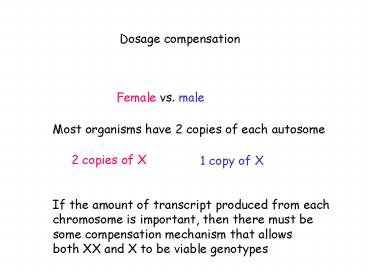Female vs' male - PowerPoint PPT Presentation
1 / 17
Title:
Female vs' male
Description:
If the amount of transcript produced from each. chromosome is important, then there must be ... X inactivation in action: Calico cats ... – PowerPoint PPT presentation
Number of Views:30
Avg rating:3.0/5.0
Title: Female vs' male
1
Dosage compensation
Female vs. male
Most organisms have 2 copies of each autosome
2 copies of X
1 copy of X
If the amount of transcript produced from each
chromosome is important, then there must be
some compensation mechanism that allows both XX
and X to be viable genotypes
2
Dosage compensation fits into the sex
determination pathways for invertebrates
C. elegans Sex determination pathway
3
C. elegans
XA ratio determines activation of dosage
compensation genes that direct the level of
expression from X
Transcription from X chromosome is decreased by
1/2 in hermaphrodites
4
Drosophila is the opposite of C. elegans
transcription from the X is increased 2x in males
No Dosage Comp.
Dosage Comp.
5
Summary of dosage compensation in Drosophila and
C. elegans
C. elegans compensates by decreasing
transcription from the Xs in females (2 X
animals) XA 0.5, XO-lethal on male sex
determination and dosage compensation XA
1.0, XO-lethal off hermaphrodite sex
determination and dosage compensation sdc-3,
dpy-26, dpy-27, dpy-28 (dcd genes) Assemble on
both X chromosomes and downregulate (by half)
transcription from each X chromosome
Drosophila compensates by increasing
transcription from the X in males (1 X
animals) XA 1.0, Sex lethal on Female sex
determination and dosage compensation XA 0.5,
Sex lethal off Male sex determination and
dosage compensation MSL-1, 3, MLE, roX
RNAs Assemble on the single X chromosome in
males and allow twice as much product to be
transcribed
6
Inactivation is random and takes place at about
the 32-cell stage
In mammals dosage compensation is accomplished
by inactivating (almost) the entire X chromosome
G, 5.22
7
The Barr body represents the inactive X
chromosome
Cell from XX female
Cell from XXX female
G, 5.21
8
X inactivation in action Calico cats
All female mammals are mosaics for genes on the
X chromosome, illustrated here by coat color. O
(orange, dominant) and o (black, recessive) are
two alleles on the X chromosome for coat color.
G, 5.22
9
Review How the structure of chromatin affects
transcription
Trancription ON
Transcription OFF
Euchromatin --loose, easy access by trx
factors --increased acetylation of
histones --decreased methylation
Heterochromatin --tight, difficult access by trx
factors --decreased acetylation of
histones --increased methylation
? inactivation methylation
10
Methylation
- Accomplished by methylases and methyl
transferases - Occurs on a cytosine (C) followed by a G
11
Differential methylation of promoters controls
the transcriptional state of genes
The methylation state of a gene can be changed
during development
5.18
12
A complex on the X chromosome, the XIC is
responsible for X inactivation
Xist
-- does not get translated into a protein --
instead, makes a long RNA that coats the
inactive X chromosome, forming an Xist-chromatin
complex How does it work?
13
The state of Xist is opposite to the rest of the
X chromosome
When Xist promoter is ON (ACTIVE,
unmethylated), Xist is made, and that X
chromosome is inactivated
When Xist promoter is OFF (INACTIVE, methylated),
Xist is not made, and that X chromosome is
active
- Further proof that Xist is responsible for
inactivation - Xist RNA localizes to the inactive X chromosome
- Xist expression precedes overt X inactivation
- If Xist is mutated, both X chromosomes remain
active - If Xist is placed onto an autosome, the
autosome - becomes inactive
14
Xist is initially transcribed on both X
chromosomes, then restricted to only the inactive
X
Before inactivation
during
after
Xist rna photo
Two Xlinked transcripts Red Pgk mRNA Blue
Xist mRNA
G, 5.23
15
How does this worK? Xist is trancribed from
different promoters at different times
P0
P1
P2
- Initial transcription of Xist is from P0 promoter
on both Xs - this RNA is unstable and degrades.
- Subsequent transcription from P1/P2 promoter
occurs only on one of the Xs - this RNA is stable
- on the other X, Xist is methylated in this
way, the activation of one X is maintained - Xist RNA then spreads along the inactive X,
presumably blocking transcription from that
chromosome.
16
Regulation of Xist how is the inactive X chosen?
Positive regulation a competence factor that
helps turn on transcription of stable Xist RNA
to initiate inactivation ? (postulated)
Negative regulation two known factors
- 1. Tsix an antisense transcript exactly
complementary to Xist, found on the opposite
strand - Tsix is expressed at high levels from the
active X chromosome and at low levels from the
inactive (the opposite of Xist). - Probably also works to block accumulation of
Xist that is transcribed early from the active X - Tsix is methylated on the inactive X while Xist
is methylated on the active X - 2. Blocking factor when bound, blocks access to
Xist enhancer, Xist not transcribed
17
How does a cell count the number of X chromosomes?
- In XO and XY individuals, the X is not
inactivated
- In XXY and XX individuals, a single X is
inactivated
- In XXX individuals, 2 Xs are inactivated
Probably cells are not actually counting the Xs,
but rather protecting only one X chromosome from
being inactivated (blocking factor must be on
autosome)































